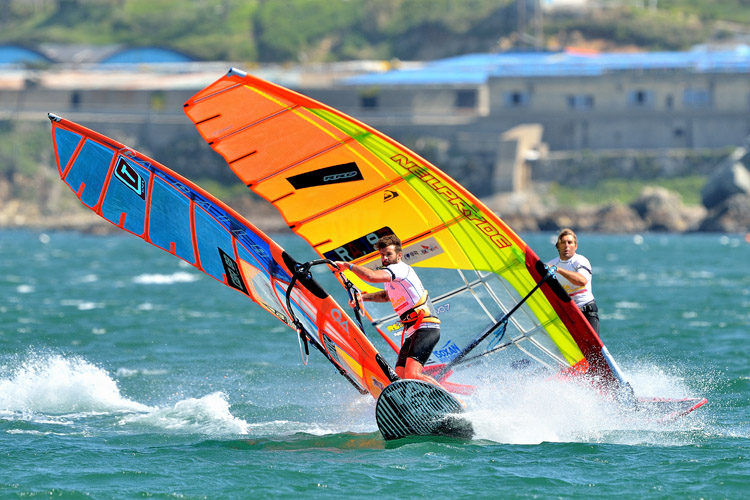Windsurfing rhymes with racing. If you want to test your competitive skills, there's nothing like a race against friends or real-life opponents. Learn what you need to become a successful slalom windsurfer.
Racing is fun and addictive. When you feel the wind blowing in your face, you just want to go faster and faster. Progression is key to crossing the finish line in the first place.
"RYA Youth Windsurfing Scheme" is a book that will help you go fast and race at a pro level.
It guides you through several stages until reaching perfection. So, how should you plan and check your steps in windsurf racing?
All three preparation levels - Start, Intermediate, and Advanced - are divided into pre-race preparation, technique tips, and racing theory.
You will progress as you tick boxes along the way.
Let's take a look at the most critical issues in competitive windsurf racing:
Pre-Race Preparation
Equipment
- Boom height;
- How to prevent boom slippage;
- Tightening battens;
- Rig setting for different conditions;
- Knowing when to change up - or down - a sail size;
- Adjustable harness lines and setting the lines in the correct position;
- Legal sail numbers and positioning;
- Rig settings using adjustable outhaul and downhaul;
- How to set up a sail for maximum performance in all conditions;
- Essential spares for competition;
- Ensuring equipment is class-legal and complies with current class rules;
Board and Kit Care
- Carry out a visual inspection (cracks, holes);
- Avoid damage, stones, and rough surfaces;
- Ensure the daggerboard works easily and effectively;
- Keep fin and daggerboard in good condition;
- Maintain foils and hull in good condition;
- Demonstrate knowledge of basic board repair;
Health and Nutrition
- Keeping hydrated;
- Using food to enhance performance;
- Knowing the effects of dehydration;
- Understanding the use of sports drinks;
Fitness
- Regular use of injury prevention techniques, warm-up/cool down, and stretching;
- Establishing a basic fitness regime for windsurfing;
- Incorporating body-weight training into a fitness program;
Technique
Starting
- Getting near the start line on the gun;
- Stopping and holding position;
- Reversing;
- Controlling the board in tight situations;
- Maneuvering under control;
- Developing a starting plan;
- Creating gaps on the start line using board control;
- Accelerating and predicting the gun to ensure speed at the start;
Speed
- Trimming the board upwind and downwind;
- Fluid tacks and gybes;
- Gybing around a mark, entering wide and exiting tight;
- Keeping clear of the wind;
- Tacking in the correct place for windward marks;
- Achieving the correct pointing angle;
- Using railing upwind;
- Rapid and efficient daggerboard movement relative to the leg of the course;
- Correct use of the harness;
- Using a tuning partner to test speed and height upwind;
- Keeping a constant and smooth angle upwind;
- Mast track adjustment;
- Solid pumping technique both upwind and downwind;
- Effective stance and control downwind;
Turning
- Faster gybing in stronger winds;
- Accelerating out of tacks and resuming pointing angle;
- Carve gybing;
- Faster 360-degree penalty turns;
Tactics and Strategy
- Leeward mark roundings;
- Deciding which side of the beat to go up and an awareness that the two sides may not be equal;
- Spotting and using wind shifts on the upwind leg;
- How to spot and react to gusts;
- Pre-race planning, checking the course, and making a decision as to which way to go;
- Recognizing and being aware of wind shifts;
- Bearing away in a gust downwind;
Racing Theory
Racing Knowledge
- The port/starboard rule;
- Wind shadows;
- The legs of a course, i.e., beat, reach, run;
- Reading racing courses;
- The windward/leeward rule;
- A standard starting sequence including flags;
- Being on the start line on the gun;
- Taking penalties (360 degrees);
- Hailing protest;
- Clear air and positioning at the start;
- The basics of the Racing Rules of Sailing (parts 1 and 2);
Wind/Weather/Tide
- Select the correct rig and equipment for the conditions;
- Understand and show awareness of the sea breeze effect;
- Predict conditions from simple weather forecasts;
- Demonstrate an awareness of the relevance and effect of tidal streams;
